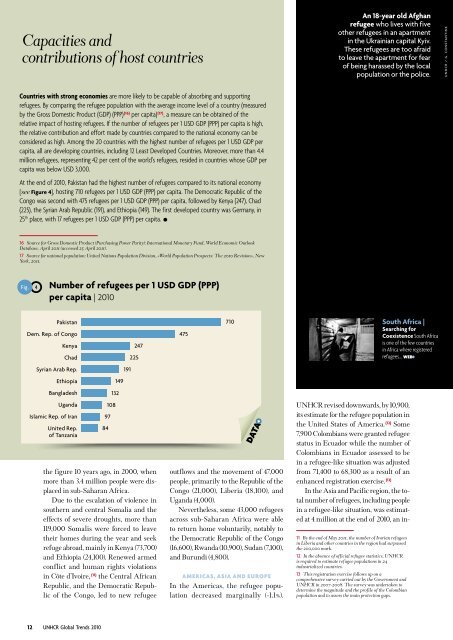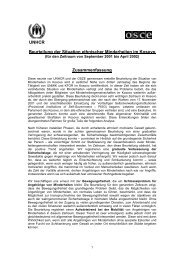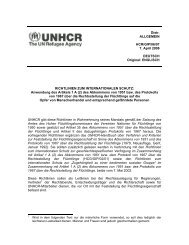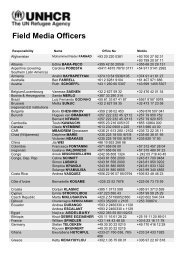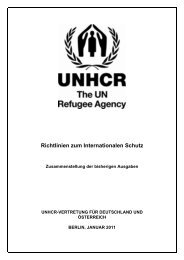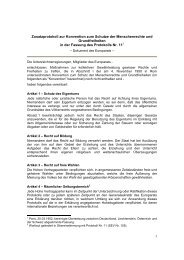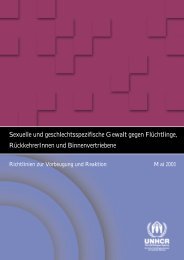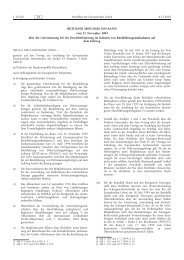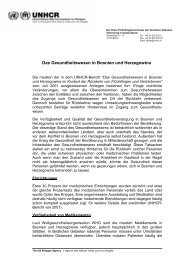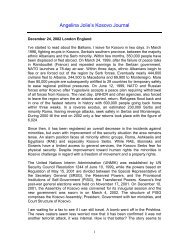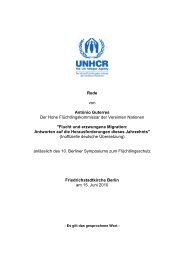EMBARGOED UNTIL MONDAY, 20 June 2011 0001 GMT ... - UNHCR
EMBARGOED UNTIL MONDAY, 20 June 2011 0001 GMT ... - UNHCR
EMBARGOED UNTIL MONDAY, 20 June 2011 0001 GMT ... - UNHCR
- No tags were found...
You also want an ePaper? Increase the reach of your titles
YUMPU automatically turns print PDFs into web optimized ePapers that Google loves.
Capacities andcontributions of host countriesAn 18-year old Afghanrefugee who lives with fiveother refugees in an apartmentin the Ukrainian capital Kyiv.These refugees are too afraidto leave the apartment for fearof being harassed by the localpopulation or the police.<strong>UNHCR</strong> / G. ConstantineCountries with strong economies are more likely to be capable of absorbing and supportingrefugees. By comparing the refugee population with the average income level of a country (measuredby the Gross Domestic Product (GDP) (PPP) (16) per capita) (17) , a measure can be obtained of therelative impact of hosting refugees. If the number of refugees per 1 USD GDP (PPP) per capita is high,the relative contribution and effort made by countries compared to the national economy can beconsidered as high. Among the <strong>20</strong> countries with the highest number of refugees per 1 USD GDP percapita, all are developing countries, including 12 Least Developed Countries. Moreover, more than 4.4million refugees, representing 42 per cent of the world’s refugees, resided in countries whose GDP percapita was below USD 3,000.At the end of <strong>20</strong>10, Pakistan had the highest number of refugees compared to its national economy[see Figure 4], hosting 710 refugees per 1 USD GDP (PPP) per capita. The Democratic Republic of theCongo was second with 475 refugees per 1 USD GDP (PPP) per capita, followed by Kenya (247), Chad(225), the Syrian Arab Republic (191), and Ethiopia (149). The first developed country was Germany, in25 th place, with 17 refugees per 1 USD GDP (PPP) per capita. •16 Source for Gross Domestic Product (Purchasing Power Parity): International Monetary Fund, World Economic OutlookDatabase, April <strong>20</strong>11 (accessed 25 April <strong>20</strong>11).17 Source for national population: United Nations Population Division, «World Population Prospects: The <strong>20</strong>10 Revision», NewYork, <strong>20</strong>11.Fig. 4 Number of refugees per 1 USD GDP (PPP)per capita | <strong>20</strong>10PakistanDem. Rep. of CongoKenyaChadSyrian Arab Rep.EthiopiaBangladeshUgandaIslamic Rep. of IranUnited Rep.of Tanzania1321089784149191225247the figure 10 years ago, in <strong>20</strong>00, whenmore than 3.4 million people were displacedin sub-Saharan Africa.Due to the escalation of violence insouthern and central Somalia and theeffects of severe droughts, more than119,000 Somalis were forced to leavetheir homes during the year and seekrefuge abroad, mainly in Kenya (73,700)and Ethiopia (24,100). Renewed armedconflict and human rights violationsin Côte d’Ivoire, (11) the Central AfricanRepublic, and the Democratic Republicof the Congo, led to new refugee475710outflows and the movement of 47,000people, primarily to the Republic of theCongo (21,000), Liberia (18,100), andUganda (4,000).Nevertheless, some 43,000 refugeesacross sub-Saharan Africa were ableto return home voluntarily, notably tothe Democratic Republic of the Congo(16,600), Rwanda (10,900), Sudan (7,100),and Burundi (4,800).americas, asia and europeIn the Americas, the refugee populationdecreased marginally (-1.1%).South Africa |Searching forCoexistence South Africais one of the few countriesin Africa where registeredrefugees…<strong>UNHCR</strong> revised downwards, by 10,900,its estimate for the refugee population inthe United States of America. (12) Some7,900 Colombians were granted refugeestatus in Ecuador while the number ofColombians in Ecuador assessed to bein a refugee-like situation was adjustedfrom 71,400 to 68,300 as a result of anenhanced registration exercise. (13)In the Asia and Pacific region, the totalnumber of refugees, including peoplein a refugee-like situation, was estimatedat 4 million at the end of <strong>20</strong>10, an in-11 By the end of May <strong>20</strong>11, the number of Ivorian refugeesin Liberia and other countries in the region had surpassedthe <strong>20</strong>0,000 mark.12 In the absence of official refugee statistics, <strong>UNHCR</strong>is required to estimate refugee populations in 24industrialized countries.13 This registration exercise follows up on acomprehensive survey carried out by the Government and<strong>UNHCR</strong> in <strong>20</strong>07-<strong>20</strong>08. The survey was undertaken todetermine the magnitude and the profile of the Colombianpopulation and to assess the main protection gaps.12 <strong>UNHCR</strong> Global Trends <strong>20</strong>10


